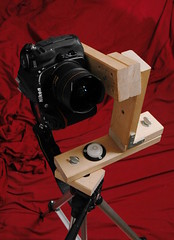Tom's Photos
Spherical Panoramas
Full Gallery - Methods - Printouts - Links
I keep meaning to make some easy to use photo-blog software and keep up this page more, but I keep getting distracted. Anyway, I have a ton more panoramas on flickr here.
If you are curious, I am using a webgl/css/javascript based panorama viewer called Pannellum.
 |
29 August 2009 Gasworks Park Taken during a national parkour jam, at Gas Works Park in Seattle, August 29, 2009. See an alternate projection of this image here. See this image on flickr. |
 |
12 June 2008 Splish Splash The famed Salmon Street Fountain during the Portland Rose Festival. The fountain has jets like this for a while then changes to a different water pattern coming from different jets. A source of great revelry on hot days in Portland. You can see the Hawthorne Bridge, and also in the distance to the left is Mt. Hood. See an alternate projection of this image here. See this image on flickr. |
 |
29 March 2008 Inside Lick Observatory's Great Refractor Dome Nestled atop Mt. Hamilton just east of San Jose, Lick Observatory, which has nothing to do with tongues, is home to several telescopes, including this gigantic refractor. This is one of the neatest interiors I've seen in a while. Visited last Decemeber, but hadn't been there since I was a kid, and it's still neat! There's a very windy road leading up to it, and I have childhood memories of trying to spot the wrecked cars that had driven off to their doom whenever we drove up. This photo is of the first telescope built on the site, which was constructed between 1876 and 1887. The body of James Lick lays entombed beneath. Beat that for ambiance!! The entire floor that you see raises and lowers so that the eyepiece of the telescope can be at eye level for the astronomers. You can see the counterweights along the walls. The telescope itself is balanced so that a single person can just grab hold of it and drag it around to point it at the right place. All in all, a neat place to visit. See an alternate projection of this image here. See this image on flickr. |
 |
16 March 2008 Iraq Body Count Exhibit You can just make out a thin strip of red flags in the distance. A sign nearby reads: "Each white flag represents at least 5 Iraqis, Each red flag represents 5 Americans killed as a result of the 2003 invasion of Iraq." As of March, 2008, iraqbodycount.org estimates about 85,000 civilians have died from violence in Iraq since 2003. This was an installation at Portland State University in Portland, Oregon, March 2008. See this image on flickr. |
 |
3 March 2008 The Quiet Before the Storm What a way to go! My second go at an enfused panorama. Much more ghosting that my first attempt, but pretty easy to clean up. See this image on flickr. |
Click for more

|
 My current panorama mount My first panoramic camera mount 
|
MethodsCurrently, I use a Nikkor 10.5mm fisheye lens on my fancy new Nikon D300, to take 6 shots around, one up, and one down. Sometimes I can get away with 4 around, one up and one down, but it's harder to get full coverage with handheld. When not shooting pictures handheld, I use a simple homemade camera mount that cost a few bucks in parts. Then I use automatic stitching software called Hugin, and usually some final touchups in the Gimp. You really don't neeeed a high end camera and lens to make photos like these, but it does make it easier! The D300, for which I blew a very noticeable chunk of savings, is a really nice camera indeed! It has a different kind of sensor (cmos) than my D70 (ccd sensor), making it less prone to purple and yellow fringes around high contrast areas, which is VERY convenient. The D300 has a zillion other useful features that make taking photos in a hurry easy. It used to take me 10 to 15 minutes to take enough photos for a panorama. Now it takes about a minute! If only the fisheye lens had vibration reduction! Someday I'll get a camera with a full-frame sensor to make low light photos better... Photography costs too much money.Older methodsIn the beginning, before I knew about automatic stitching software such as Hugin+enblend, I made spherical panoramas with the camera mount shown at left (which cost me about $10 in parts), plus a 2 megapixel point and shoot camera with about a 70 degree field of view. This allowed me to take 30 photos, each photo corresponding to a single face of a 30 sided rhombic triacontahedron. Then, I would use my program Laidout to arrange the 30 separate photos approximately into a net. Then, I'd use the Gimp to manually touch up the 60 edges, usually very labor intensive! Also, owing to my cheap little camera, most of my older panoramas suffered from the camera often focusing on the mount, rather than the scene. Finally, the net could then be printed out, cut, and folded up. See examples below. While I now use a less imposing mount, it is still much cooler to have a triacontahedron mount. |
|
It's lots of fun to build panoramas that are projected onto strange surfaces, cut and folded up.
Polyhedra and other curved surfaces (like globes) offer a huge variety of shapes to play with..
You can see some of
my projections here. Some others doing very
interesting similar things are Seb Perez-Duarte,
David Swart,
and Lloydb (maker of Flexify). |
| Stephen Wiltshire, the living camera | www.stephenwiltshire.co.uk |
| Sphere paintings by Dick Termes | www.termespheres.com |
| Seamless city of San Francisco | www.seamlesscity.com |